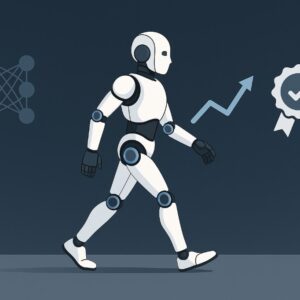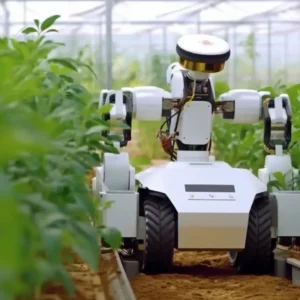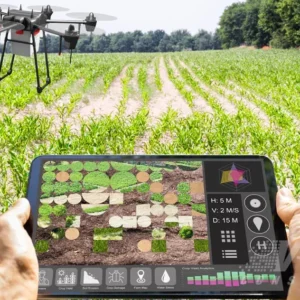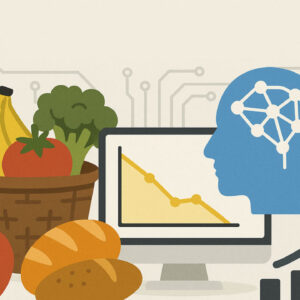Food fraud poses significant challenges to global food systems, with detrimental effects on consumer health, economic stability, and industry trust. This phenomenon involves intentional misrepresentation, adulteration, or counterfeiting of food products for economic gain. The food industry has long sought effective solutions to mitigate fraud, and Artificial Intelligence (AI) has emerged as a transformative technology in this domain. Leveraging machine learning, image recognition, natural language processing, and predictive analytics, AI is revolutionizing the detection and prevention of food fraud.
AI provides an unparalleled ability to process vast datasets, detect anomalies, and uncover patterns that signal fraudulent activities. By combining AI with complementary technologies like blockchain and spectroscopy, industries can enhance transparency and traceability throughout the supply chain. These advancements not only safeguard consumers but also protect brands and promote sustainable practices. As fraudsters continue to devise sophisticated methods, the dynamic capabilities of AI offer a proactive and adaptive approach to combating food fraud.
This article explores the role of AI in food fraud detection, its applications, challenges, and potential for transforming the industry.
The Problem of Food Fraud
Food fraud is a multifaceted issue that spans global supply chains and diverse product categories. Common practices include adulterating products with cheaper ingredients, mislabeling origins or production methods, and substituting premium items with lower-quality alternatives. Examples range from mixing cheaper oils into olive oil to misrepresenting farmed fish as wild-caught.
The financial impact is staggering, with estimates of global losses reaching billions of dollars annually. Beyond economic harm, food fraud compromises consumer safety. Adulterated products often contain harmful substances, such as melamine in the milk or illegal dyes in spices, leading to public health crises. Moreover, the reputational damage to brands involved in fraud—whether knowingly or through lapses in oversight—can be irreparable.

Traditional methods of detecting fraud, such as manual inspections and basic chemical tests, are limited in scope and efficiency. As supply chains grow increasingly complex, there is a pressing need for innovative solutions to address this pervasive issue. AI offers a powerful and scalable approach to meet these challenges.
How AI Detects Food Fraud
AI employs a range of techniques to identify food fraud across various stages of the supply chain. These methods leverage advanced computational capabilities to analyze data, identify inconsistencies, and predict fraudulent activities.
- Computer Vision for Visual Inspection
AI-powered computer vision systems analyze food images to detect anomalies in appearance, such as color, texture, or shape. For instance, AI can identify subtle differences between authentic and adulterated products that may elude human inspectors. - Chemical Analysis with AI
Spectroscopy and chromatography generate detailed chemical profiles of food products. Machine learning models analyze this data to detect adulterants or verify authenticity. This approach is particularly effective in identifying contaminants or substitutions in high-value items like honey, wine, and dairy products. - Natural Language Processing (NLP)
AI uses NLP to scrutinize labels, certificates, and documentation for inconsistencies. This technology can detect errors in geographical indications or production claims, ensuring compliance with regulatory standards. - Predictive Analytics
By analyzing historical data, AI predicts fraud-prone points in the supply chain. For example, algorithms can identify suppliers with recurring irregularities or detect patterns that suggest tampering during transit.
These techniques enable businesses to implement proactive measures, reducing fraud risks and enhancing overall food safety.
Real-World Applications
AI’s versatility has made it a valuable asset across various sectors of the food industry. Each application highlights its potential to address specific fraud challenges:
- Dairy Industry
Adulteration in milk, such as adding water or synthetic compounds, is a common issue. AI systems analyze chemical compositions to detect such adulterants, ensuring product quality and safety. - Seafood Authenticity
Mislabeling of fish species is prevalent, particularly with premium varieties like tuna or salmon. AI analyzes DNA sequencing data to verify species, preventing substitution and ensuring compliance with labeling laws. - Wine and Spirits
Counterfeit alcoholic beverages pose significant risks to consumer health and brand integrity. AI models assess chemical markers, packaging details, and even cork patterns to distinguish authentic products from fakes. - Meat Products
AI enhances traceability by analyzing data from farm to fork. It can identify discrepancies in records or perform DNA analysis to detect substitutions in processed meats.
These examples demonstrate how AI adapts to the unique requirements of different food categories, making it a versatile tool in fraud prevention.
Combining AI with Blockchain Technology
The integration of AI and blockchain represents a powerful synergy for combating food fraud. Blockchain provides an immutable ledger for recording every transaction and movement within the supply chain. This transparency ensures that each step is documented and verifiable.
AI complements blockchain by analyzing the vast data stored on these ledgers. For instance, AI algorithms can flag unusual patterns, such as repeated discrepancies in shipment weights or unexpected changes in supply chain timelines. This combination enables real-time monitoring and early detection of fraudulent activities.
Moreover, blockchain enhances consumer trust by providing a traceable record of a product’s journey. When paired with AI-driven insights, it empowers consumers with accurate information about food origins, production methods, and quality standards. This integration not only addresses fraud but also supports ethical sourcing and sustainability initiatives.
Benefits of AI in Food Fraud Detection
AI offers several compelling advantages that make it a cornerstone of modern food fraud prevention strategies:
- Speed and Efficiency
AI processes large datasets at unparalleled speeds, making it ideal for industries with extensive supply chains. This efficiency reduces the time required to detect and address fraud. - Accuracy and Adaptability
Machine learning models continuously improve as they analyze more data, enhancing their ability to identify fraud with precision. Additionally, AI’s adaptability allows it to respond to evolving fraud tactics. - Cost-Effectiveness
Automating fraud detection reduces reliance on manual inspections, lowering operational costs while maintaining high accuracy levels. - Enhanced Consumer Trust
By ensuring product authenticity, AI fosters trust among consumers, strengthening brand loyalty and market reputation.
These benefits highlight AI’s potential to transform the food industry, providing robust solutions to long-standing challenges.
Challenges in Implementing AI for Food Fraud Detection
While AI offers significant promise, its adoption in food fraud detection faces several hurdles:
- Data Limitations
AI models rely on high-quality, comprehensive datasets. Incomplete or inaccurate data can undermine their effectiveness, leading to false positives or missed fraud instances. - Integration Complexities
Incorporating AI into existing supply chain systems can be challenging, requiring significant infrastructure changes and technical expertise. - Cost Barriers
The initial investment in AI technology may deter small-scale producers, limiting its widespread adoption. - Evolving Fraud Tactics
Fraudsters continuously adapt their methods, necessitating regular updates to AI models to maintain their efficacy.
Addressing these challenges requires collaboration between industry stakeholders, governments, and technology providers to ensure equitable and effective implementation.
Ethical and Regulatory Considerations
The deployment of AI in food fraud detection raises important ethical and regulatory questions. Ensuring data privacy and avoiding biases in detection algorithms are critical to maintaining stakeholder trust. Transparency in AI operations is essential to avoid skepticism and ensure accountability.
Furthermore, equitable access to AI tools must be prioritized to prevent small-scale producers from being excluded from these technological advancements. Governments and non-governmental organizations can play a crucial role in promoting inclusive adoption through subsidies, training programs, and regulatory frameworks.
A Sustainable Future with AI in Food Fraud Detection using AI
Beyond fraud detection, AI contributes to broader sustainability goals by optimizing resource use and reducing waste. Authenticating food products ensures that resources are directed toward genuine, high-quality production, minimizing losses associated with counterfeit or adulterated items.
Moreover, AI supports sustainable practices by identifying inefficiencies within the supply chain, promoting responsible consumption, and reducing the carbon footprint associated with fraudulent activities. These efforts align with global initiatives to achieve Sustainable Development Goals (SDGs) related to food security, economic growth, and environmental preservation.
Expanding the Scope of AI in Food Fraud Detection
As AI technologies continue to evolve, their applications in food fraud detection are expected to expand further. Emerging innovations such as edge computing, advanced sensor technology, and federated learning hold promise for more effective and widespread use of AI in this critical field.
Edge Computing for Real-Time Detection
Edge computing enables the processing of data closer to its source, such as on devices within factories or distribution centers. This allows AI systems to detect fraud in real time without relying on cloud connectivity, which can be slower and less secure. For instance, smart sensors integrated with edge AI can immediately identify discrepancies in product composition during manufacturing, preventing fraudulent items from entering the supply chain.
Enhanced Sensor Technology
The development of AI-compatible sensors capable of detecting minute changes in physical or chemical properties adds another layer of precision to fraud detection. These sensors can be deployed at critical points in the supply chain, providing continuous monitoring and immediate alerts when anomalies are detected.
Federated Learning for Collaborative Solutions
Federated learning, which allows multiple entities to collaborate on training AI models without sharing sensitive data, is a game-changer for the food industry. It enables companies to benefit from collective insights while maintaining data privacy and compliance with regulations. This approach is particularly valuable for multinational organizations operating across diverse regulatory environments.
Educating the Industry and Consumers
The successful implementation of AI in food fraud detection also requires efforts to educate both industry stakeholders and consumers about its benefits and limitations.
Training for Industry Professionals for Food Fraud Detection using AI
Workshops and training programs can equip supply chain managers, quality assurance teams, and other professionals with the knowledge to implement and maintain AI systems effectively. Understanding how AI algorithms work, what data is needed, and how to interpret results ensures that these tools are used to their full potential.
Consumer Awareness Campaigns
Educating consumers about how AI safeguards food authenticity can build trust and encourage informed purchasing decisions. Simple initiatives, such as QR codes on packaging that link to blockchain-backed product histories, empower consumers to verify the authenticity of their purchases.
These educational efforts not only enhance the effectiveness of AI-driven fraud detection but also foster a culture of transparency and accountability within the industry.
Global Collaboration for Maximum Impact
Food fraud is a global issue that transcends borders, requiring collaborative solutions. International organizations, governments, and private sector stakeholders must work together to create standardized frameworks for AI deployment in fraud detection.
Standardized Data Sharing Protocols for Food Fraud Detection using AI
Global standards for data sharing ensure that AI models have access to diverse, high-quality datasets, improving their accuracy and reliability. Collaborative platforms can facilitate this exchange while safeguarding sensitive information.

Cross-Border Regulations
Harmonizing regulations across countries can streamline the adoption of AI technologies, enabling companies to deploy consistent fraud detection measures in all markets. This reduces the risk of loopholes that fraudsters can exploit.
Public-Private Partnerships
Collaboration between governments, academic institutions, and private companies can drive innovation in AI tools while ensuring that their benefits are accessible to all industry players. Joint research initiatives and funding programs can accelerate the development of cutting-edge solutions.
Through such collaborative efforts, AI’s potential to combat food fraud can be fully realized on a global scale.
Conclusion
AI is revolutionizing food fraud detection, providing advanced tools to tackle one of the industry’s most pressing challenges. By leveraging technologies such as computer vision, chemical analysis, and blockchain integration, AI enhances transparency, efficiency, and consumer trust across the supply chain.
While challenges in data quality, integration, and cost remain, the benefits of AI far outweigh its limitations. Its ability to adapt to evolving fraud tactics ensures that the food industry remains vigilant and proactive. The continued collaboration between technology developers, regulators, and industry stakeholders will be crucial in fully realizing AI’s potential.
As the fight against food fraud intensifies, AI stands as a beacon of innovation and resilience, safeguarding consumer health, protecting brand integrity, and promoting a sustainable future. The adoption of AI-driven solutions marks a transformative step toward a safer, more trustworthy global food system.













